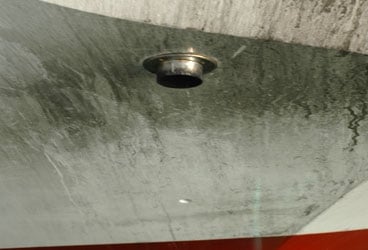
In addition to what you can discern from testers and gauges, the smoke coming from your sailboat’s diesel engine can help alert you to current and potential problems.
White Smoke
White smoke from a marine diesel engine is one of the most difficult symptoms to diagnose because a number of factors can point to two general causes: overcooling, whereby the cylinder head and combustion chambers operate at a temperature that’s too low for proper combustion; and piston-ring blowby, which indicates low compression and poor combustion.
White smoke represents atomized fuel, very small droplets of fuel that form a fog of sorts. It’s common, and quite normal, to see this when a cold engine is started and until it warms up. If, however, a preheat device such as glow plugs or an air-intake heater are malfunctioning, the production of white smoke may be excessive and longer lasting. In extreme cases, the engine may be difficult or impossible to start.
Fuel of poor quality, particularly fuel that’s off spec or not properly formulated as Number 2 diesel, will burn poorly, which in turn may produce white smoke. Adding a fuel cetane booster may temporarily alleviate—and identify—this problem.
Other causes of white smoke coming out of boat exhaust are poorly adjusted valves or worn valve seats, a partially activated decompression lever, a blown head gasket, or a cracked cylinder head or cylinder liner. A mechanic with the proper tools can narrow down the suspects.
Black Smoke
This indicates the presence of unburned or partially burned fuel. The most common cause for this is overloading, sometimes referred to as overfueling because more fuel is fed into the engine than it can efficiently burn. This can occur, say, when a sailboat is docking and the engine is momentarily gunned, emitting a puff of black smoke. A constant plume of black while running under heavy load, or even at ordinary cruising rpm, is evidence of chronic overfueling, typically caused by a propeller with too much pitch or too great a diameter. Or it may be that the prop is fouled; just a few hard barnacles are all it takes. Worn, carbon-encrusted, or malfunctioning injectors or a clogged or wet air filter may also be to blame for black smoke.
Blue Smoke
This, on the other hand, is typically created when crankcase oil is burned in the engine’s combustion chambers, possibly causing carbon buildup there. Worn valve stems or guides (stems are the thin shafts on exhaust and intake valves; guides are the tubes in which they move) can let oil sneak past to mix with the fuel. Because oil is a much heavier distillate than diesel, it doesn’t burn completely, which results in carbon formation and blue smoke. Determining which culprit has produced the blue smoke—the valve stems and guides, or the piston rings—calls for a cylinder differential leak-down test, a procedure that can be performed by a diesel mechanic. It requires compressed air, so it’s typically carried out at a boatyard.
Engine Tip
White smoke can indicate overheating, but the “smoke” is actually steam that’s produced in the exhaust system rather than as a result of an overheating engine. This may occur, for instance, because of restrictions in the injected elbow. To test for this, measure water temperature in the “wet” portion of the exhaust hose; it should be below 200F.
Steve D’Antonio offers services for boat owners and buyers through Steve D’Antonio Marine Consulting.








